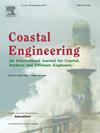Wave-plus-current induced span shoulder migration in three dimensional scour around submarine pipeline
IF 4.2
2区 工程技术
Q1 ENGINEERING, CIVIL
引用次数: 0
Abstract
The purpose of this study is to investigate the rate of span shoulder propagation under conditions of waves and current. The study analyzed 117 cases from previous and present investigations, which were divided into three categories: pure wave, wave-plus-current, and pure current. Furthering the framework of Sui et al. (2021) for pure current conditions, the relative current strength was included in the present study to incorporate the effects of the wave component in a general wave-plus-current condition, through a systematic dimensional analysis. For a given excess Shields parameter, the pure current case has the largest migration velocity compared to the wave conditions. Incorporating the wave components into the pure current decreases the rate of the span shoulder propagation. A new model is proposed to predict the rate of span shoulder propagation while considering the dependency of current strength, excess Shields parameter, and embedded depth. The new model has a determination coefficient of 0.8, indicating its ability to accurately predict the rate of the span shoulder propagation under general wave and current conditions. Parametric studies show that increasing the excess Shields parameter increases the migration rate while increasing the embedment depth, ratio of the pipe diameter to the grain diameter decreases it.
海底管道周围三维冲刷中波浪加水流诱导的跨肩迁移
本研究的目的是调查波浪和水流条件下跨肩的传播速度。本研究分析了以往和当前研究中的 117 个案例,将其分为三类:纯波浪、波浪加水流和纯水流。在 Sui 等人(2021 年)针对纯水流条件的框架基础上,本研究通过系统的维度分析,将相对水流强度纳入到一般波浪加水流条件下的波浪分量的影响中。对于给定的过量希尔兹参数,与波浪条件相比,纯水流情况下的迁移速度最大。在纯电流中加入波浪成分会降低跨肩的传播速度。我们提出了一个新模型来预测跨肩的传播速度,同时考虑了水流强度、过量盾构参数和嵌入深度的相关性。新模型的确定系数为 0.8,表明其能够准确预测一般波浪和水流条件下的跨肩传播速度。参数研究表明,增加过量盾构参数会增加迁移率,而增加嵌入深度和管道直径与晶粒直径之比会降低迁移率。
本文章由计算机程序翻译,如有差异,请以英文原文为准。
求助全文
约1分钟内获得全文
求助全文
来源期刊

Coastal Engineering
工程技术-工程:大洋
CiteScore
9.20
自引率
13.60%
发文量
0
审稿时长
3.5 months
期刊介绍:
Coastal Engineering is an international medium for coastal engineers and scientists. Combining practical applications with modern technological and scientific approaches, such as mathematical and numerical modelling, laboratory and field observations and experiments, it publishes fundamental studies as well as case studies on the following aspects of coastal, harbour and offshore engineering: waves, currents and sediment transport; coastal, estuarine and offshore morphology; technical and functional design of coastal and harbour structures; morphological and environmental impact of coastal, harbour and offshore structures.
 求助内容:
求助内容: 应助结果提醒方式:
应助结果提醒方式:


